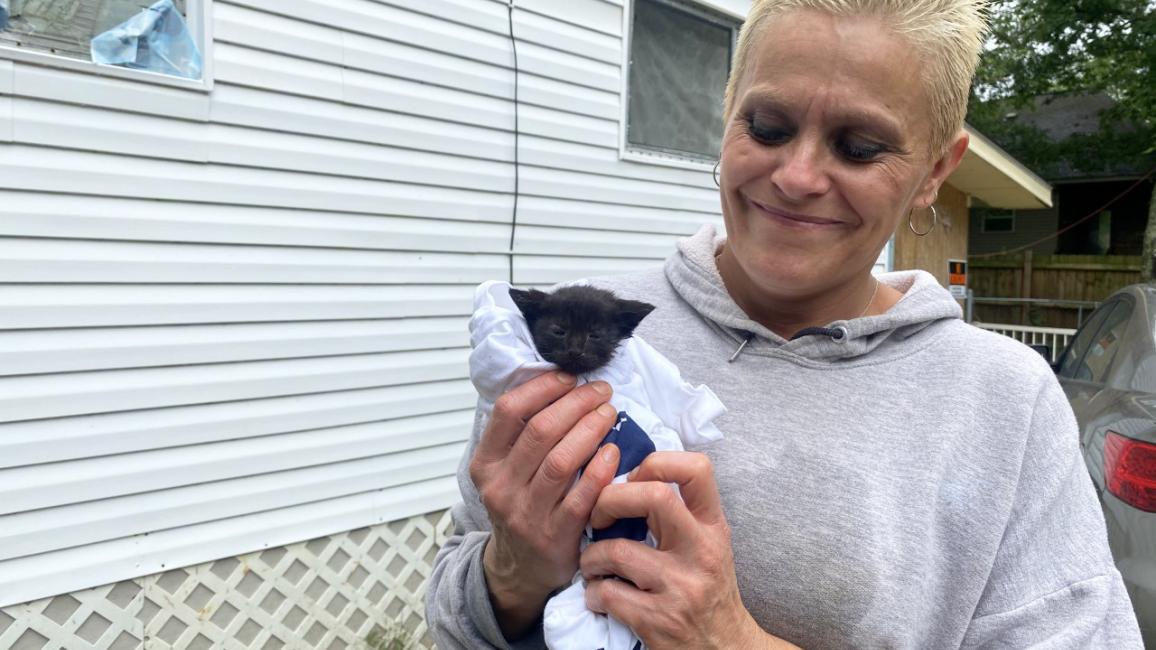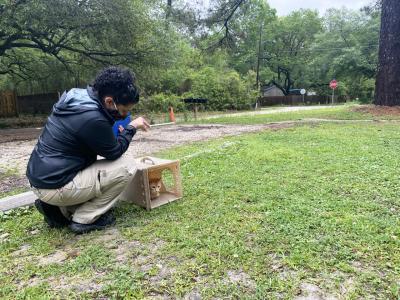Community conversations help cats in a Louisiana parish

In February of 2021, Leah Long started working with the staff at St. Tammany Parish (Louisiana) Department of Animal Services shelter to help take its cat lifesaving efforts to the next level as part of the Best Friends national embed program (made possible by a grant from Maddie’s Fund®). There was just one challenge: At the time, decades- old parish ordinances were in place that prevented the shelter from returning any cats back to where they were found, unless the staff had permission from the property owner.
Still, Leah had good reason to believe that the collaboration between the shelter and Best Friends could make a huge difference for cats in St. Tammany, especially considering a recent leadership change, with Robert Bremer being appointed shelter director and Penny Brunies as assistant shelter director. “Penny and Robert really gave the staff voices and a platform to advocate for pets and their community,” says Leah.
[Second chance for more than 1,000 cats in New Mexico]
This had energized the staff, which now was excited to come to work and was receptive to learning new ways to help pets in need. Penny also advocated for a new position, community cat coordinator, and Jessica White stepped into that role.
We wanted to change but had been doing the same things for too long,” says Penny. “Leah helped us get organized and brought some great ideas to help us turn things around and make a big difference for our parish.”

Taking it to the streets
The first step to creating more positive outcomes for cats in St. Tammany was to build conversation points to share with the community on the benefits of the shelter’s trap-neuter-vaccinate-return (TNVR) program. Then it was time to go out and meet neighbors and have those conversations.
Together, Leah and the team visited areas they knew had high concentrations of outdoor cats and talked with residents about the importance of TNVR. Being out in the community also gave the staff a chance to connect with neighbors and see the impact of its work. “When you’re in the shelter and animals come in, it can feel one-dimensional,” says Leah. “The more we can get out and talk with people, the more we can see things from a broader perspective.”

Friendly cats can live outdoors, too
At first, many of the shelter staff were having a tough time returning friendly outdoor cats — that is until they met a particularly friendly cat brought to the shelter by people who found the friendly feline hanging out on their property.
When the cat was neutered, vaccinated, microchipped and ear-tipped at the shelter, Leah, along with Jessica and the rest of the shelter staff, placed him in a carrier and took him back to where he’d been found. While they were canvasing the community, a group of kids recognized the cat as the same cat being cared for by a woman who lived a couple of blocks away. “That’s Gizmo!” the woman exclaimed when she saw him in the carrier, happy to see him. The feeling was apparently mutual as Gizmo appeared to be more than a little relieved to be back.
That day, the shelter team talked with Gizmo’s caretaker about the TNVR services they offered and left information with her. From then on, she knew she had a partner to contact for help with cats like Gizmo. “Leah really gave us the tools that we needed to be able to solve almost any community cat problem,” says Jessica.

Conversations for kittens
Kitten season has a way of taxing shelters all over the country, and St. Tammany is no exception. Even though kittens come to the shelter all year long due to the warm climate, during the summer months they can come in daily by the dozens. To keep newborn kittens out of the shelter, the embed team worked closely with the staff to create a plan that could help give kittens a positive outcome.
The kitten intake prevention plan provided talking points for the front desk team to use when engaging people surrendering kittens, which included urging them to return the kittens to where they were found, so that their mom cat could continue to nurse them.
[‘First responder program’ saves newborn kittens]
Those front desk conversations also helped the staff identify where outdoor cats might be living, so any unaltered cats could be humanely trapped, spayed or neutered, vaccinated, ear-tipped and returned to their neighborhoods. “This is just another example of solution-oriented thinking,” says Leah. “When the community understood they were part of the solution, they started to get more involved and these conversations only got stronger.”

A huge win for cats in St. Tammany
In August of last year, the parish council prepared to vote on whether to update ordinances to allow for comprehensive community cat programming that would give the shelter more leverage for TNVR.
Prior to the vote, Penny provided each council member with a huge packet of information detailing the benefits of TNVR. She also invited community cat advocates to the parish council meeting. Tammany residents packed the room with people supporting ending restrictions in the current ordinance to allow for comprehensive community cat programming. That night, there was unanimous support for updating the ordinance. “This is a huge win,” says Leah.
[Saving cats at Palm Valley Animal Society in Texas]
It's a win, not just for St. Tammany’s cats, but for the community, too. Today, the cat save rate at the shelter is above 90%. “We are very proud of how far we’ve come,” says
Penny. “And we could not have gotten here without the help and support of Best Friends.”

Seeing stray cats?
Trap-neuter-vaccinate-return (TNVR) programs prevent countless litters from entering the shelter system.
Take Action for Community Cats
Read more
Embed program helps cats and people who love them in North Carolina